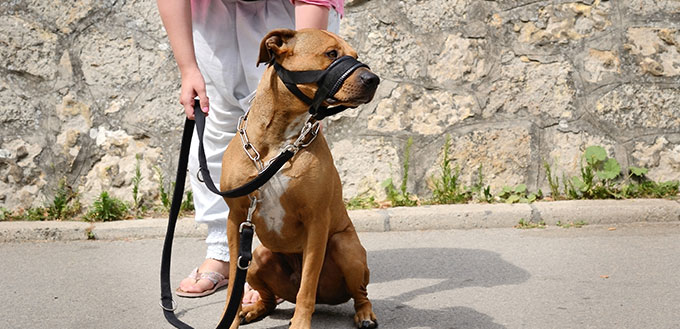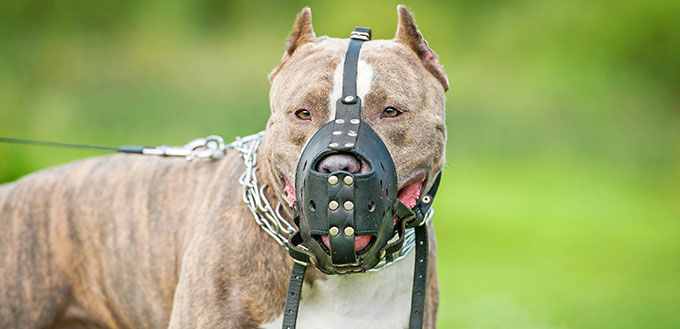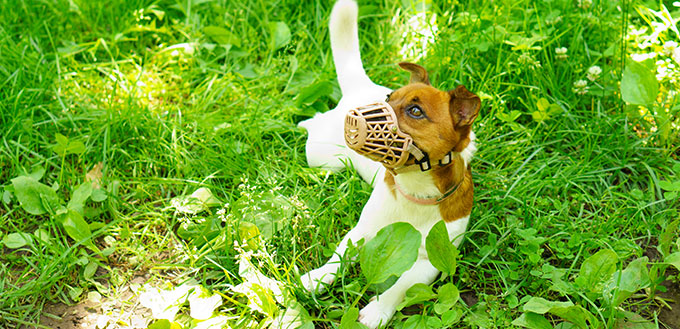There are certain misconceptions regarding muzzles, a lot of people associate the muzzle with a dog that must be vicious when this is not necessarily the case. If you’re wondering whether you should look to muzzle train your pooch but you’re unsure where to start, we’re here to tell you where to begin, right down to know how to put a muzzle on a dog, muzzle training, and the reasons behind why you may need to muzzle your dog.
What is a Muzzle?
A muzzle is a device designed to fit around a dog’s mouth to prevent them from opening it. Dog muzzles are used for a wide variety of reasons, ranging from basic training techniques to preventing barking and aggressive behavior. Its bad reputation often makes owners afraid to use it, but it can be an extremely useful tool when used properly and responsibly, and shouldn’t be dismissed so easily.
Why Might my Dog Need a Muzzle?
There are actually quite a few reasons why a dog muzzle might need to be used, most of which are related to behavior modification in some way or another. Here are the main reasons why you might need to muzzle your dog:
- Vet Visits: The vets can be a high source of anxiety for a pup, especially if they have had the misfortune of requiring many invasive visits at an early. The fear and anxiety connected with e vet can make even the most docile dogs a bit jumpy. Now muzzles may not be needed in this instance to stop them from biting, it could just be that their behavior is a bit erratic and they become unpredictable or aggressive when in that environment. In this situation, having your dog wearing a muzzle during the visit will just give everyone peace of mind, and can help to calm the dog too.
- In case of Emergencies: It can be good to keep a muzzle in your walking bag in case you ever come across a dog that appears to be injured or lost. Their confusion or pain can cause them to become defensive and aggressive, and having a basket muzzle to hand can be a game-changer. However, if you don’t feel it is safe to attempt to put it on, then call a professional and try to keep a safe distance whilst monitoring the injured or lost pup.
- Grooming Sessions: Similarly to the problem with the vet, some dogs are not big fans of going to a groomer, though depending on the breed they may not have a choice. Groomers often have to deal with aggressive dogs and so they are no stranger to a muzzled pup.
- Training: Muzzle training is a surprisingly common technique. It can be used when a household gets a new dog until they can be sure that it will behave (this is particularly common with rescue dogs going to homes with other pets or young children). And believe it or not, highly trained security dogs often wear muzzles in public settings when they are off duty to ensure that they behave properly.
- Aggressive Behavior: The best-known reason why some dogs wear a muzzle is due to aggression. Some dogs do have difficulty with aggressive behavior that can be the result of past trauma, natural instinct, bad training, or ailments that cause them pain, and so sometimes the best approach is to keep them muzzled around other dogs and unfamiliar people. Aggressive does not necessarily mean vicious and is often the result of fear, pain, or anxiety.
- Breed Laws: There are some areas that do unfortunately have legislation for certain breeds that force them to be muzzled in public, due to them being classified as “dangerous”. Or there are also places that restrict all dogs to a muzzle on public transport.
How to Muzzle Train Your Dog
This is the tricky bit, muzzle training can be long-winded, and some dogs can take a while to adjust before they are able to wear a muzzle comfortably. if you need to use a muzzle, there’s no other way around it, you just need to persevere and exercise patience. Here is our best advice for how to muzzle train a dog.
Introducing the Muzzle
It all comes down to positive reinforcement when looking at how to muzzle a dog and introducing the muzzle to your dog for the first time. It is a slow process to begin with, of getting them just to put their nose in the muzzle first, and the best way to do this is to put a treat into the bottom of the basket, or on your hang at the other end of the muzzle, so that they see it like a puzzle or a bowl with a tasty reward at the bottom. You must be careful not to force the muzzle onto their nose and allow them to be comfortable and move their face away from it whenever they way.
Fastening the Muzzle
Once your dog is familiar with the muzzle and happy to put its nose inside, or even excited to do so, it’s time to start adjusting them to the idea of wearing it.
The first thing to remember is that the clip will be fastening right behind their ear, so before you click it closed around their face, start by just opening and closing the buckle next to their ear (it would be a good idea to lay down dog treats at the same time for some positive reinforcement). Once they seem completely unphased by the fastening sound, you can begin to get them used to the straps.
Now, continuing to use the treat reward technique, place more treats into the muzzle (peanut butter can be great for keeping their nose in longer), and then once they seem comfortable keeping their nose in it for longer periods of time you can start training your dog to become comfortable with the straps. So whilst they have their nose in the muzzle, gradually move the straps around, then slowly bring them up around your pups head, it would be advisable to keep the straps long for this part. Only when your pooch seems happy wearing the muzzle on their nose and having the muzzle straps draped around their neck would you then begin to try and fasten the strap.
Go by your dog’s pace, if this stage seems to upset them then undo the straps and continue with draping them until they seem comfortable enough for you to try again. You want wearing the muzzle to be a relaxing and joyful experience.
How to Remove the Muzzle
Now, this is the easy part! Once you have your dog wearing a muzzle comfortable, you can remove the muzzle, and then just focus on gradually extending the time in which they wear a muzzle, starting with a couple of minutes, and slowly working your way up to an hour. So simply unclick the muzzle, gently remove it, and reward their patience and good behavior with another treat for good measure. You can also show your dog the muzzle afterward, with another treat, to reassure them that it is nothing to be afraid of if they seem a bit shaken, before putting the muzzle away.
How Not to Use a Muzzle
There are a few ways in which a dog muzzle should never be used. A muzzle is meant to be a support, comfort, and training tool using positive reinforcement, and the most unacceptable use of a muzzle is to use it as a punishment. In stressful situations, what you don’t want is for your dog to have a negative reaction to its muzzle. If a dog starts to associate the muzzle with negative emotions you will find that they become difficult to muzzle, which will only cause further stress for you and your pup and aggravate their aggression or even be the cause of it along with inciting other behavioral problems. A Muzzle must also never stop your dog from feeding or drinking.
How Long Can a Dog Wear a Muzzle?
A muzzle is not a permanent tool, and should only be worn for a short amount of time, and only when it is needed. A veterinarian, for example, will likely place the muzzle onto your dog themselves if they feel the need, and they will determine how long it will need to stay on.
The general rule of thumb is that a muzzle shouldn’t stay on for longer than an hour. So whilst training or in a public place, be sure to remember that time frame as a great guideline. If your dog is the type to need more than an hour of exercise a day, consider finding a place to take them where a muzzle isn’t required.
Different Types of Muzzles
There are several types of muzzles on the market today, generally speaking, it comes down to two main types, which are nylon muzzles, or basket muzzles.
- The Basket Muzzle
A basket muzzle is probably the better known of the two and is a structured muzzle that has straps that fasten around the head, holding the basket in place. Basket muzzles are usually made with leather, plastic or wire, and are always padded to protect your pup’s nose. Basket muzzle designs like the Baskerville Ultra Muzzle tend to be the most sought after owing to their secure fastenings and carefully designed basket. Basket Muzzles are the best design for muzzle training as the shape makes the process much easier, and allows you to give treats to your dog whilst they are wearing it.
Read our in-depth Baskerville Ultra Muzzle Review.
- The Nylon Muzzle
Nylon muzzles are the type that you will often see a veterinarian use. They are an easy to slip on, properly fitted muzzle that is made to keep a dog’s mouth closed whilst not affecting the dog’s ability to breathe freely.
How to Fit a Muzzle on a Dog
All muzzles should come with a size guide, either in the form of measurements or recommended breeds. But if you are still unsure of how to fit the correct sized muzzle for your dog, you can always ask the advice of a professional, such as a vet.
Will a Muzzle Hurt my Dog?
Hopefully, this article has cleared your trepidations about using a muzzle for your dog, and when fitted and used correctly a muzzle will not cause a dog any harm. If you worry that it may start rubbing their nose, you can always wrap a soft fabric around the nose area just to be sure. When purchasing your muzzle just be sure to get the correct size and go about training in the correct way and everything will be fine.
You will know your dog better than anyone. If they struggle with severe behavioral issues, you may want to approach a professional for advice before proceeding, as the help of a trainer may be required for the initial steps. But you feel that they would benefit from the discipline that a muzzle can provide, then it is certainly worth giving it a go.
Sources:
- Dr. Debra Horwitz, Muzzle Training for Dogs, VCA Animal Hospitals
- Stephanie Gibeault, MSc, Dog Muzzles: What You Should Know about When, Why, and How to Use One, AKC
- Muzzle Training: Dog Training Plan, Best Friends Animal Society










